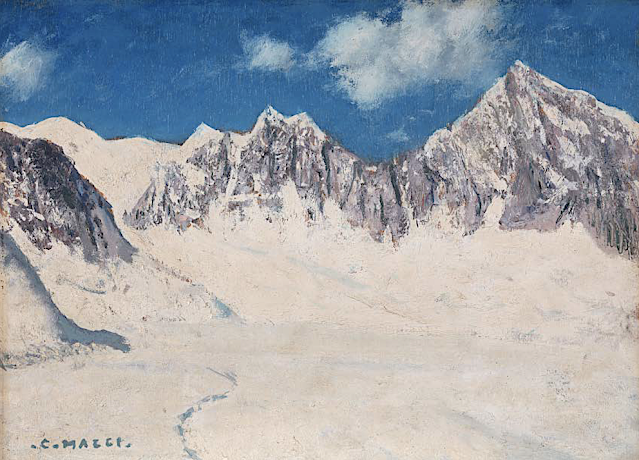Mont Blanc du Tacul (4,248m -13,937 ft)
France ( Haute-Savoie)
In Mont Blanc du Tacul seen from the Glacier du Géant, Chamonix, France. oil on panel, 27 x 37cm, courtesy John Mitchell Gallery, London
The mountain
Mont Blanc du Tacul (4,248m - 13,937 ft) is a mountain in the Mont Blanc massif of the French Alps situated midway between the Aiguille du Midi and Mont Blanc. The Mont Blanc du Tacul looks like a large, snow-covered trapezoid. It is part of the peaks of the Alps over 4,000 meters, of which it is the twenty-fourth highest. To the north of the summit is the Aiguille du Midi, from which it is separated by the Col du Midi (3,532 m), to the south the Mont Maudit, from which it is separated by the Col Maudit (4,035 m), at the is the Aiguilles du Diable then the Glacier du Géant and to the west the Aiguille de Saussure (3,839 m) then the Bossons glacier which rises to its summit. It has a secondary summit, the eastern summit (4,247 m), which is the exit from the Gervasutti pillar. The official first ascent of Mont Blanc du Tacul was by a guideless party comprising Charles Hudson, Edward John Stevenson, Christopher and James Grenville Smith, E. S. Kennedy, Charles Ainslie and G. C. Joad on 8 August 1855. However, Courmayeur guides may have already ascended the peak during their attempts in 1854 and 1855 to force a way up Mont Blanc from the Italian side.
The painter
The italian painter Cesare Maggi was born into a family of actors, Maggi embarked on classical studies at his father’s wish but also took up painting at a very early age His debut in Florence at the Esposizione Annuale della Società di Belle Arti di Firenze in 1898 was followed by a short trip to Paris to catch up with the latest developments.
The crucial turning point in Maggi’s art came in 1889 with the posthumous show of work by Giovanni Segantini held by the Milanese Society of Fine Arts, which prompted a definitive shift to landscape painting of a Divisionist character. After a short stay in the Engadin, he returned to Milan before finally settling in Turin. Commercial collaboration with Alberto Grubicy until 1913 enabled Maggi to establish himself quickly as one of the leading representatives of the second generation of Divisionist painters in Italy. He painted a repertoire of readily comprehensible mountain landscapes focusing primarily on aspects of the visual perception of the reflection of light and colour but lacking the deep spirituality of Segantini’s work. He took part in the major Italian and European exhibitions and the Venice Biennale devoted an entire room to his work at the Esposizione Internazionale d’Arte of Venice in 1912. After an interlude devoted to portrait painting in the same decade, the artist’s mature work focused on greater simplification of subject matter, mostly in landscapes.
Maggi obtained the chair in painting at the Albertina Academy, Turin, in 1936.
___________________________________________
2021- Wandering Vertexes...
by Francis Rousseau

No comments:
Post a Comment